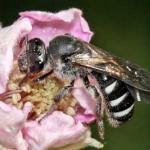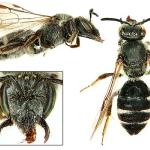Lasioglossum nitidum CURTIS 1833
A southern, restricted species, occurring mainly in East Anglia and Surrey. It is also known from the Channel Islands (Sark). Old information for Hampshire, Devon, Cornwall and Lancashire requires confirmation. Abroad, this is a central and southern Palaearctic species, widely distributed and sometimes common in Europe. Found from Spain east to Mongolia.
Listed in the Appendix of Shirt (1987), i.e. thought to be extinct, and as RDB1 in Falk (1991). Since 2001, there have been over a dozen localities discovered in south-east Suffolk. There have also been sporadic records from Breckland in both Suffolk and Norfolk.
In Suffolk and Norfolk, it has been recorded from sandy heath (including golf courses), breckland heath, gardens, allotments and areas of waste ground on light, sandy soils.
Univoltine. The British flight period is hard to determine, due to the paucity of data but the female appears in April and both sexes have been found in August. In Poland, Pesenko et al. (2000) state that both sexes can be found for nearly the whole flight period, April to October. It is felt likely that this long flight period will be mirrored in the resurgent Suffolk population.
Apparently, the nesting biology has not been established, even where the species is common abroad. In 2018, a female was found to be nesting in a lawn in a suburban garden in Ipswich, Suffolk, climbing down blades of grass to reach the burrow entrance in a sparsely vegetated patch.
Recent observations on flowers visited include Bramble (Rubus fruticosus agg.), White Bryony (Bryonia dioica), dandelion (Taraxacum sp.), Common Figwort (Scrophularia nodosa), Buckthorn (Rhamnus cathartica), Hemlock (Conium maculatum), Foxglove (Digitalis purpurea), poppies (Papaver sp.) and ragwort (Senecio jacobaea). Some of these plants may represent pollen sources.
No information available.
Proofed: January 2012
Updated: June 2017



